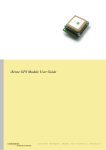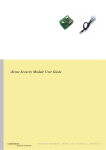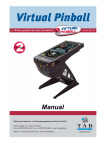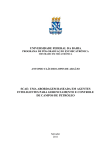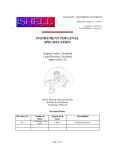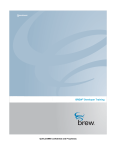Download Coalesenses iSense User guide
Transcript
UZL-Testbed User Guide
FRONTS
Foundations of Adaptive Networked Societies of Tiny Artefacts
www.fronts.cgi.gr
UZL-Testbed User Guide
Document history
Version
Date
Changes
1.0
01.08.2009
Initial version
1.1
05.10.2009
iShell documentation added
1.2
31.05.2010
Revised
2 / 18
Foundations of Adaptive Networked Societies of Tiny Artefacts
UZL-Testbed User Guide
Contents
1.
About this User Guide .................................................................................................................... 4
2.
General Description of the UZL-Testbed ....................................................................................... 5
3.
Simulating the UZL-Testbed .......................................................................................................... 6
4.
Using the testbed .......................................................................................................................... 11
4.1.
Connecting a local iShell2 to the gateway node 0x94a0........................................................ 12
4.2.
Flashing the gateway node..................................................................................................... 13
4.3.
Flashing the network over the air........................................................................................... 15
4.4.
Closing the connection........................................................................................................... 17
3 / 18
Foundations of Adaptive Networked Societies of Tiny Artefacts
UZL-Testbed User Guide
1. About this User Guide
In this user guide,
•
files and folders are represented in the Arial typeface,
•
code fragments, function names etc. are represented in the Courier New typeface,
•
GUI elements such as button descriptions etc. are represented in “quotation marks”,
•
titles of other documents are presented in Italic type.
This manual assumes that the reader has successfully installed the iSense development environment,
and obtained the iSense standard firmware. For further information on theses steps, consult the
Development Environment Setup User Guide [1].
In addition, it is assumed that the user is familiar with the use of iShell. For further information on
iShell, consult the iShell User Guide [2].
For further information on iSense firmware programming concepts and on application development, it
is recommended to read the Writing iSense Applications User Guide [3].
4 / 18
Foundations of Adaptive Networked Societies of Tiny Artefacts
UZL-Testbed User Guide
2. General Description of the UZL-Testbed
This user guide describes
•
how the UZL-testbed looks like, and
•
how an application can be simulated in Shawn using the same environment parameters.
So far, the testbed comprises the 22 iSense sensor nodes (of type R1) shown in Table 1: MAC
addresses of UZL-testbed nodes.. Two of them are so-called gateway nodes equipped with a Core
Module (cf. [4]) with SMA antenna and a Gateway Module (cf. [5]) connected to a computer. The
Gateway Modules enable power supply and communication of the node to iShell running on the
connected computer and vice versa. The Gateway Module can also be used to program the connected
Core Module.
The ordinary sensor nodes are equipped with a Core Module with SMA antenna and a Security
Module including a PIR (passive infrared) sensor and an accelerometer. They are plugged to power
outlets. Technical data, software documentation and a demo application concerning the Security
Module can be found in [6].
MAC (Hex)
06 0D
06 0e
06 14
06 17
06 35
06 40
08 78
08 7f
78 54
78 56
78 57
78 5c
78 68
78 6a
94 73
94 7d
94 7e
94 7f
94 83
94 9e
94 a0
94 a4
MAC (Dec) Type
1549
1550
1556
1559
1589
1600
2168
2175
30804
30806
30807
30812
30824
30826
38003
38013
38014
38015
38019
38046
Gateway
38048
Gateway
38052
Table 1: MAC addresses of UZL-testbed nodes.
A node is identified uniquely by its MAC address. The first column of Table 1 shows the MAC
addresses as hexadecimal, the second column as decimal value. For example, using the command
os().debug(“My id is %x = %d.”, os().id(), os().id())
results in the following output in the SerialMonitor-Plugin of iShell:
My id is 0x94a0 = 38048.
5 / 18
Foundations of Adaptive Networked Societies of Tiny Artefacts
UZL-Testbed User Guide
Figure 1: Deployment of the sensor nodes within the Institute of Telematics
Figure 1 shows the spatial arrangement of the sensor nodes within the Institute of Telematics in
Lübeck. The sensing ranges of the PIR sensors are indicated by light green cones. The range of such a
sensor goes up to 10m in a free area, but walls and furniture limit them literally in indoor scenarios.
The two gateway nodes are not equipped with a PIR sensor.
3. Simulating the UZL-Testbed
This section describes how simulations can be run with the parameters of the UZL-testbed. We assume
that the reader is used to Shawn configuration files to control a Shawn simulation run. As JShawn
6 / 18
Foundations of Adaptive Networked Societies of Tiny Artefacts
UZL-Testbed User Guide
offers scripting functionality and the use of local variables we use JShawn to configure the simulation.
Refer to [7] for detailed information.
The testbed topology is described by /scenario_fronts.xml. The xml-file defines the real positions of
the nodes as well as the link properties between nodes.
As the simulator uses increasing numbers from 0 to n as ids for n+1 nodes for an efficient algorithmic
processing we added functionality in iSense enabling the usage of arbitrary ids. Setting the global
variable use_tag_ids to “true” in your configuration file like
shawn.setGlobalVariable("use_tag_ids", "true");
causes that iSense ids are read from a node tag called “isense_id” which is also defined in the xml-file.
Note, that os().id() has not necessarily the same value as os().proc().owner().id() in this case!!
To find a Shawn::Node by its iSense MAC address (os().id()) use the method
class ShawnGlueProcessor
{
static shawn::Node* find_node_by_id_w(shawn::World& w_,uint16 i)throw();
}
instead of owner().world().find_node_by_id( 1234 ).
Example: ShawnGlueProcessor::find_node_by_id_w((ShawnOs* &os_)->proc().
owner_w().world_w(), 0x060d);
The above mentioned xml-file contains these ids additionally to the positions:
<scenario>
<snapshot id="0">
…
<node id="19"><location x="3.0" y="2.6" z="0.0"/>
<tag type="int" name="isense_id" value="38048"/>
<!-- Hex: 94 a0 -->
</node>
…
</snapshot>
</scenario>
You can load this snapshot by using the shawn command load_world:
shawn.runCommand("load_world", "world_in_file=scenario_fronts.xml
snapshot=0 processors=isense");
7 / 18
Foundations of Adaptive Networked Societies of Tiny Artefacts
UZL-Testbed User Guide
Table 2: Real and Shawn MAC addresses shows the Shawn ID for each node which is returned by
os().proc().owner().id(). Normally, the application should neither know nor use them. iSense hides
them completely.
MAC (Hex)
06 0D
06 0e
06 14
06 17
06 35
06 40
08 78
08 7f
78 54
78 56
78 57
78 5c
78 68
78 6a
94 73
94 7d
94 7e
94 7f
94 83
94 9e
94 a0
94 a4
Shawn ID
0
1
2
3
4
5
6
7
8
9
10
11
12
13
14
15
16
17
18
19
20
21
Table 2: Real and Shawn MAC addresses
The JShawn-file /configuration.jshawn contains all commands to execute one simulation run with the
UZL-testbed parameters. A simulation includes generating the world, establishing a connection to
iShell if required, enabling logging tasks and running the simulation.
//-----------------------------------------------// Simulation parameters
//-----------------------------------------------// Determines if the simulation shall wait to be connected to iShell
boolean connect_to_ishell = true;
// Number of executed iterations
int iterations = 5000;
// The random seed. Use something greater or equal zero to enable the seed
int seed = 1;
The link qualities between nodes are defined in the environment. To enable these you must
•
set the variable “env_config” in your xml-file which contains the environment when you
create the Shawn world (with the prepare_world-command) and
•
use the Shawn “linkprobability” communication model. Here, each (unidirectional)
communication link is defined by setting its probability for a successful packet transmission.
A link probability of 0.5 means that every second packet is lost.
8 / 18
Foundations of Adaptive Networked Societies of Tiny Artefacts
UZL-Testbed User Guide
//-----------------------------------------------// Shawn models and scenario parameters
//-----------------------------------------------// Shawn edge model
String em = "simple";
// Shawn communication model
String cm = "link_probability";
// Shawn transmission model
String tm = "csma";
// File containing the UZL testbed positions and ids
String scenario = "scenario_fronts.xml";
//Set the seed
if( seed > 0 )
shawn.runCommand("random_seed", "action=set seed=" + seed);
// Use the ids of the fronts testbed instead of 0 to 21
shawn.setGlobalVariable("use_tag_ids", "true");
int range = 35;
//Create a new simulation world and set its parameters
shawn.runCommand("prepare_world","edge_model=" + em +
" comm_model=" + cm + " range=" + range + " size_hint=" + range +
" transm_model=" + tm + " bandwidth=16000 csma_type=802.15.4
immediate_delivery=true" + " env_config=" + scenario);
shawn.setGlobalVariable("count","22");
// Load the fronts scenario
shawn.runCommand("load_world", "world_in_file="+scenario+" snapshot=0
processors=isense");
You can run simulations with and without connecting Shawn to iShell. To connect Shawn to iShell use
the ShawnSocketTask as follows.
//-----------------------------------------------// Connection to iShell
//-----------------------------------------------if (connect_to_ishell)
shawn.runCommand("ShawnSocketTask","socket_port=1280
socket_blocking=true");
For each ShawnSocketTask in the JShawn-file open an iShell instance. In iShell, the address has to be
set to localhost and the port to the value set in the JShawn-file (1280 in the example). The Main node
connects iShell to one node. If your iSense application implements the UartPacketHandler interface
and is registered for at least one packet type, the iShell-Messenger-Plugin can send (uart) messages to
this node. Since node 0x94a0 is the gateway node in the UZL-testbed, set “38048” as main node.
The range debug nodes in iShell specifies the set of nodes from which messages will be transmitted to
the iShell. “*” means all nodes. “2157, 1549” means nodes 0x87f and 0x60d. They can be set to
9 / 18
Foundations of Adaptive Networked Societies of Tiny Artefacts
UZL-Testbed User Guide
arbitrary values. If you run the application their debug output will be shown in the Serial Monitor
plugin. Note, that it depends on the value of use_tag_ids if the numbers from 0 to n or the decimal
values of the MAC addresses must be used for a successful communication between Shawn and iShell.
Shawn offers the possibility of tracing radio messages and fill levels of queues in files while the
simulation is running. The following values for parameter create are implemented:
•
postscript_messages
•
msg_density_postscript
•
postscript_queues
•
postscript_timeout_task_queues
•
postscript_memory
•
gnuplot_memory
//-----------------------------------------------// Logging parameters (tracing in files)
//-----------------------------------------------// Trace every single message in the network into a .ps file
//shawn.runCommand("isense_trace", "create=postscript_messages
file=messages.ps message_delta=1");
// Trace the message density on the links of the network into a .ps file
//shawn.runCommand("isense_trace", "create=msg_density_postscript
file=msg_density.ps time_delta=100 max_width=3");
// Trace incomming and outgoing radio queues of the nodes into a .ps file
//shawn.runCommand("isense_trace", "create=postscript_queues
file=radio_queues.ps time_delta=1.0");
// Trace the timeout and task queues of the nodes into a .ps file
//shawn.runCommand("isense_trace", "create=postscript_timeout_task_queues
file=timeout_queues.ps time_delta=1.0");
// Trace the heap usage of the nodes into a .ps file
//shawn.runCommand("isense_trace", "create=postscript_memory
file=memory.ps time_delta=1.0");
// Trace the detailed heap usage of the nodes into a gnuplot data file
//shawn.runCommand("isense_trace", "create=gnuplot_memory fmalloc=1
ffree=1 nodes=* file=mem-of-node-");
Finally, run the simulation task to launch the execution of the simulation.
//-----------------------------------------------// Execution
//-----------------------------------------------// Run the simulations
shawn.runCommand("simulation", "max_iterations="+iterations);
10 / 18
Foundations of Adaptive Networked Societies of Tiny Artefacts
UZL-Testbed User Guide
4. Using the testbed
Before you flash your application on the nodes ensure
•
that your application does not sleep at all or that the device wake up from time to time so that
they can be reprogrammed (e.g., by calling the command os().allow_sleep(false);
in the boot-method),
•
that your application runs on radio channel 21 (by calling the
os().hardware_radio().set_channel(21); in the boot-method),
•
that your application can be stopped somehow if it sends many messages, because otherwise a
reprogramming becomes impossible. The TopologyRecognition application [8] uses for
example the flooding protocol to send a STOP-command to all nodes which sets a boolean
variable SEND to false, and
•
that the iSense firmware version that you use contains over the air programming with
multihop support, so that the testbed remains programmable while your application is
running. Therefore, you have to enable the check box “Multihop support” in ->Protocols>Over-the-air Programming Protocol (OTAP) when building the iSense firmware (indicated
by the red box in the following screenshot).
command
Important: If you are unsure if devices running your application are programmable over the air
do not immediately program the entire network! Program only one node and reprogram it again to
test if it works fine. Then, program all other nodes.
11 / 18
Foundations of Adaptive Networked Societies of Tiny Artefacts
UZL-Testbed User Guide
4.1. Connecting a local iShell2 to the gateway node 0x94a0
First tell somebody in Lübeck who is in touch with the testbed (e.g. via email), that you want to use
the testbed and for how long you will probably need it. If nobody else is using the testbed, this person
will start the server to which you can connect your client. If a test is currently running on the testbed,
the person will tell you when it will be free again.
To start an iShell on your computer:
•
Download ishell2.zip from [8] and unzip it.
•
Start ishell.exe.
Then, open the ConnectionManagerView and click on Remote iShell Device (1). Enter the server
address 141.83.68.132 as well as the port number 1282 (c.f. 2). Now, click on Open Connection (3).
The connection will be established. If there is a problem with that, let somebody in Lübeck know
about it.
12 / 18
Foundations of Adaptive Networked Societies of Tiny Artefacts
UZL-Testbed User Guide
4.2. Flashing the gateway node
Note, that you have to flash the gateway node (using the iShell Flash Loader Plugin) separately from
all other nodes which are programmed over the air. Either program the gateway node with a so-called
Data-Collector-and-iSeraerial application (you can find the corresponding bin-file at [8]) or enable
the iSeraerial including multihop support functionality of iSense in your application by
1. selecting iSeraerial support (first line in the red box 3)
2. constructing
an
IShellInterpreter
enable_seraerial() on it:
in
your
application
and
calling
IShellInterpreter *isi_ = new IShellInterpreter(os());
isi_->enable_seraerial();
If you want to the gateway node to collect the results of your test via the data exchange protocol
enable the DataExchanger (red box 2). It collects the data of all registered DataProviders
using the tree routing protocol. For the data collection the gateway node must run the above mentioned
Data-Collector-and-iSeraerial application or you must enable the Data Collector -> Multihop support
(last line in box 3).
13 / 18
Foundations of Adaptive Networked Societies of Tiny Artefacts
UZL-Testbed User Guide
•
To flash the gateway node open a flash loader (2) connected to the Remote iShell Device (3).
•
Switch to the generated Flash loader Plugin instance (1).
•
Then, select the bin-file you want to flash on the node (2).
•
Click on the Start button (3) and wait until the flash process has been finished.
14 / 18
Foundations of Adaptive Networked Societies of Tiny Artefacts
UZL-Testbed User Guide
4.3. Flashing the network over the air
•
First, open the PluginManagerView.
•
Then, click on Over the air Programming (1).
•
Select the remote iShell Device (2) and
•
click on Add new Plugin instance (3) to generate an instance of this plugin.
•
Select the new plugin instance.
•
Select the bin-file containing your program which you want to run on the testbed (1).
•
Click on Multihop programming (2).
•
Select radio channel 21 as this is the channel of FRONTS users in Lübeck (3).
•
Click on Start presence detection (4).
15 / 18
Foundations of Adaptive Networked Societies of Tiny Artefacts
UZL-Testbed User Guide
The Status column (1) shows the application identification and software revision number of the
currently running application. They can be used to verify that the correct program is running after
the flashing. (To do this verification, run the presence detection after the flashing for a short time
and stop it after the devices appeared in the list.)
•
When 21 devices are detected, click on Select all (2) and Start programming (3).
•
Wait until the Status is Done. Then, you can start your test.
16 / 18
Foundations of Adaptive Networked Societies of Tiny Artefacts
UZL-Testbed User Guide
4.4. Closing the connection
Open again the ConnectionManagerView and select the Remote iShell connection to the gateway node
(1) and close the connection via button 2.
17 / 18
Foundations of Adaptive Networked Societies of Tiny Artefacts
UZL-Testbed User Guide
References
[1] coalesenses Development Environment Setup User Guide, online available at
http://www.coalesenses.com/download/UG_development_environment_setup_v1.9_web.pdf
[2] coalesenses iShell User Guide, online available at
http://www.coalesenses.com/download/UG_ishell_v1.3.pdf
[3] coalesenses
Writing
iSense
Applications
User
Guide,
online
available
http://www.coalesenses.com/download/UG_writing_isense_applications_1v1.pdf
at
[4] coalesenses iSense Core Module User Guide, online available at
http://www.coalesenses.com/download/UG_CM10X_1v0.pdf
[5] coalesenses iSense Gateway Module User Guide, online available at
http://www.coalesenses.com/download/UG_GM10X_1v0.pdf
[6] coalesenses iSense Security Module User Guide, online available at
http://www.coalesenses.com/download/UG_SM10AX_1v0.pdf
[7] ShawnWiki at http://shawn.sourceforge.net/
[8] UZL Testbed Documentation at http://fronts.cti.gr/index.php/testbed
[9] Topology Recognition Application User Guide, online available at http://www.itm.uniluebeck.de/projects/fronts/TopologyRecognitionApplication.zip?lang=de
18 / 18
Foundations of Adaptive Networked Societies of Tiny Artefacts


















